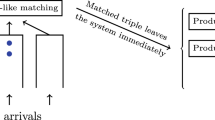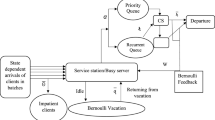Abstract
Real-time scheduling, or scheduling with respect to a deadline, is critical in many application areas such as telecommunications, control systems, and manufacturing. This paper presents a novel approach to real-time scheduling based on a queueing theory model. Using real-time queueing theory (RTQT), one can analytically determine the distribution of the lead-time profile (i.e., the time until the deadline is reached) of customers waiting for service. Emphasis is placed on the development of the equations used to determine the lead-time profile distribution. The development of the GI/G/1 case is presented and confirmed using simulation. Simulation results confirm prior research for the M/M/1 and GI/M/1 case. As a practical application, RTQT is used to implement a packet admission control algorithm for a telecommunications network. Using this algorithm, packet lateness was reduced by up to 31%.
Similar content being viewed by others
References
A.S. Alfa, A discrete MAP/PH/1 queue with vacations and exhaustive time-limited service, Oper. Res. Lett. 18(1) (1995) 31–40.
D.Y. Burman, An analytic approach to diffusion approximations in queueing, Ph.D. dissertation, Department of Mathematics, New York University (1979).
L.Y. Dar and S.C. Maw, A two-machine flowshop sequencing problem with limited waiting time constraints, Comput. Industr. Engrg. 28(1) (1995) 63–70.
W. Feller, An Introduction to Probability Theory and Its Applications, Vol. 1, 3rd ed. (Wiley, New York, 1968).
W. Feller, An Introduction to Probability Theory and Its Applications, Vol. 2 (Wiley, New York, 1971).
I. Frigui and A.S. Alfa, Analysis of a time-limited polling system, Comput. Commun. 21(6) (May 1998) 558–571.
J.L. Kelley and I. Namioka, Linear Topological Spaces (Van Nostrand, New Jersey, 1963).
J.F.C. Kingman, On queues in heavy traffic, J. Roy. Statist. Soc. Ser. B 24 (1962) 383–392.
L. Kleinrock, Queueing Systems, Vol. 1: Theory (Wiley, New York, 1975).
L. Kleinrock, Queueing Systems, Vol. 2: Computer Applications (Wiley, New York, 1976).
J.P. Lehoczky, Real-time queueing theory, in: Proc. of the 17th IEEE Real-Time Systems Symposium (December 1996) pp. 186–195.
J.P. Lehoczky, Using real-time queueing theory to control lateness in real-time systems, Performance Evaluation Rev. 25(1) (1997) 158–168.
J.P. Lehoczky, Personal correspondence with R.O. Baldwin (5 July 1997).
J.P. Lehoczky, Real-time queueing network theory, in: Proc. of the 18th IEEE Real-Time Systems Symposium (December 1997) pp. 58–67.
C.L. Liu and J.W. Layland, Scheduling algorithms for multiprogramming in a hard real time environment, J. Assoc. Comput. Mach. 20(1) (1973) 46–61.
L. Liu, B.R. Kashyap and J.G. Templeton, The service system /M/M/supR/ infinity with impatient customers, Queueing Systems 2(4) (1988) 363–372.
R.E. Moore, Computational Functional Analysis (Halsted Press, New York, 1985).
OPNET Modeler, MIL 3, 3400 International Drive NW, Washington.
N.L. Polyayev, Nonstationary characteristics of a single channel system with a constraint on the waiting time, Soviet J. Comput. Systems Sci. 24(4) (1986) 116–121.
S.S. Panwar, D. Towsley and J.K. Wolf, Optimal scheduling policies for a class of queues with customer deadlines to the beginning of service, J. Assoc. Comput. Mach. 35(4) (1988) 832–844.
N. Sugakkai, Encyclopedic Dictionary of Mathematics (MIT Press, Cambridge, MA, 1977).
Y.Q. Zhao and A.S. Alfa, Performance analysis of a telephone system with both patient and impatient customers, Telecommunication Systems 4(3–4) (1995) 201–215.
Z.X. Zhao, S.S. Panwar and D. Towsley, Queueing performance with impatient customers, in: IEEE INFOCOM '91, pp. 400–409.
Author information
Authors and Affiliations
Rights and permissions
About this article
Cite this article
Baldwin, R.O., Davis IV, N.J., Kobza, J.E. et al. Real-time queueing theory: A tutorial presentation with an admission control application. Queueing Systems 35, 1–21 (2000). https://doi.org/10.1023/A:1019177624198
Issue Date:
DOI: https://doi.org/10.1023/A:1019177624198




